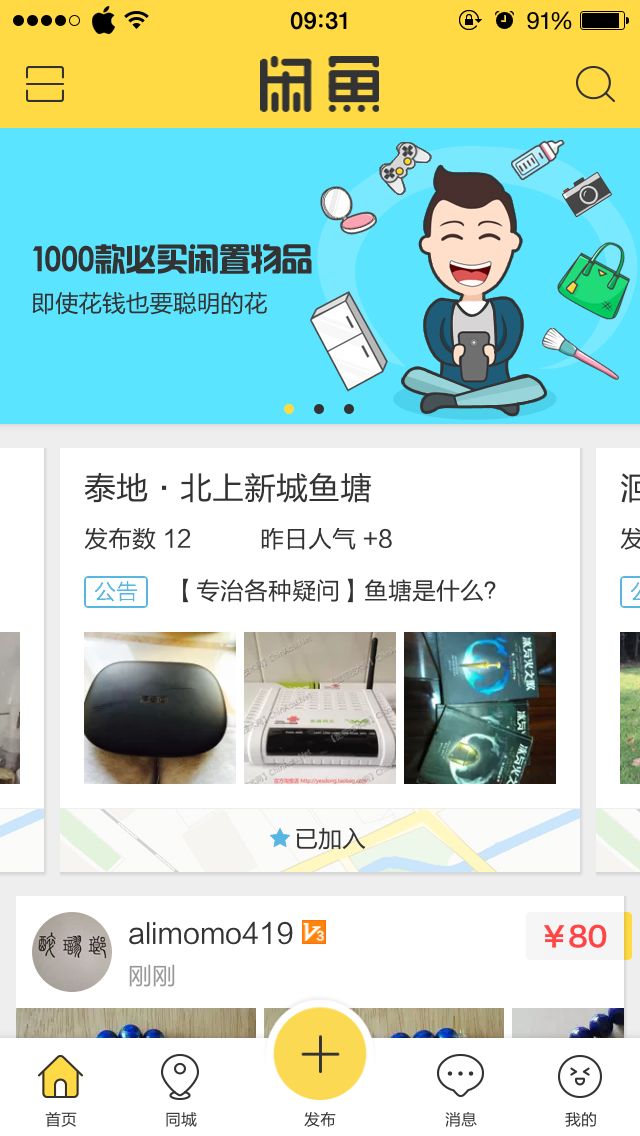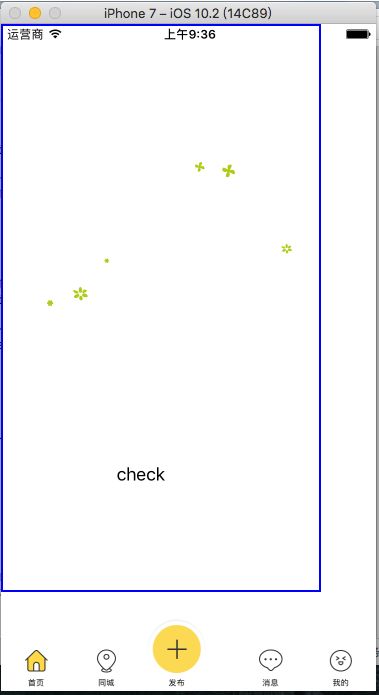本文主要讲解实现中间凸起的圆形TabBar控制器,使用咸鱼App进行例子参考
之前在讲解完基本的控件的使用后,一直想讲解下Tabbar的使用,刚好有个机会可以结合凸起的圆形TabBar来讲解下TabBar的基本使用过程,首先我们在讲解TabBar之前,我们先介绍下UITabBarController:
UITabBarController
UITabBarController就是一个类似于上面咸鱼显示的视图控制器页面,其可以添加多个控制器进行切换显示;还提供了一个UITabBar类来允许用户进行控制器视图的切换。
首先我们来基本使用下UITabBarController去构建一个视图页面
using System;
using UIKit;
namespace TabbedApplication {
public class TabController : UITabBarController {
UIViewController tab1, tab2, tab3;
public TabController ()
{
tab1 = new UIViewController();
tab1.Title = "Green";
tab1.View.BackgroundColor = UIColor.Green;
tab2 = new UIViewController();
tab2.Title = "Orange";
tab2.View.BackgroundColor = UIColor.Orange;
tab3 = new UIViewController();
tab3.Title = "Red";
tab3.View.BackgroundColor = UIColor.Red;
var tabs = new UIViewController[] {
tab1, tab2, tab3
};
ViewControllers = tabs;
}
}
}
其中ViewControllers就是设置UITabBarController 里面的多个视图控制器,设置其的ViewControllers数组,即在底部显示多少个相应的tabbaritem。
同样我们可以自定义相应的UITabBarItem的样式,已达到相应的业务要求
tab1.TabBarItem = new UITabBarItem (UITabBarSystemItem.Favorites, 0);
tab2 = new UIViewController ();
tab2.TabBarItem = new UITabBarItem ();
tab2.TabBarItem.Image = UIImage.FromFile ("second.png");
tab2.TabBarItem.Title = "Second";
tab2.View.BackgroundColor = UIColor.Orange;
tab3.TabBarItem.BadgeValue = "Hi";
这就是基本的UITabBarController的使用,我们可以添加多个控制器,自定义相应的TabBarItem的显示样式,去丰富我们的界面显示元素。
MYTabBar
根据了上边的UITabBarController的简单使用介绍,我们发现对于单单使用UITabBarController去实现咸鱼那样凸起的圆形TabBar其实是无法直接实现的,这里我们需要去自定义我们的TabBar试图。
首先我们先自定义TabBarItem,这里我们称为MYTabBarItem,其本质是一个按钮,我们去重新设置他的图片和文字的显示位置即可
public enum LLTabBarItemType
{
Normal = 0,
Rise,
}
public class MYTabBarItem : UIButton
{
static public string kLLTabBarItemAttributeType = "MYTabBarItemAttributeType";
static public string kLLTabBarItemAttributeTitle = "MYTabBarItemAttributeTitle";
static public string kLLTabBarItemAttributeNormalImageName = "LLTabBarItemAttributeNormalImageName";
static public string kLLTabBarItemAttributeSelectedImageName = "LLTabBarItemAttributeSelectedImageName";
public LLTabBarItemType tabBarItemType{get;set;}
public MYTabBarItem(CGRect frame) : base(frame)
{
if(this != null)
config();
}
public MYTabBarItem()
{
if (this != null)
config();
}
private void config()
{
this.AdjustsImageWhenHighlighted = true;
this.ImageView.ContentMode = UIViewContentMode.ScaleAspectFit;
}
public override void LayoutSubviews()
{
base.LayoutSubviews();
this.TitleLabel.SizeToFit();
CGSize titleSize = this.TitleLabel.Frame.Size;
UIImage image = this.ImageForState(UIControlState.Normal);
CGSize imageSize;
if (image == null)
{
imageSize = new CGSize(0,0);
}
else
{
imageSize = this.ImageForState(UIControlState.Normal).Size;
}
if (imageSize.Width != 0 && imageSize.Height != 0)
{
nfloat imageViewCenterY = this.Frame.Height - 3 - titleSize.Height - imageSize.Height / 2 - 5;
this.ImageView.Center = new CGPoint(this.Frame.Width / 2, imageViewCenterY);
}
else
{
CGPoint imageViewCenter = this.ImageView.Center;
imageViewCenter.X = this.Frame.Width / 2;
imageViewCenter.Y = (this.Frame.Height - titleSize.Height) / 2;
this.ImageView.Center = imageViewCenter;
}
CGPoint labelCenter = new CGPoint(this.Frame.Width / 2 ,this.Frame.Height -3 - titleSize.Height/2 );
this.TitleLabel.Center = labelCenter;
//Console.WriteLine(this.ImageView.Frame);
}
这里我们需要在LayoutSubviews方法里面对按钮的label和image位置进行重新布局,调整label显示在图片的上边。这里我们需要自定义一个属性去区分是否为中间圆形TabBarItem。
注意事项:
1、当我们重写LayoutSubviews方法时候,我们千万不能忘记base.LayoutSubviews();如果不添加此行代码无法显示成功。
2、LayoutSubviews在什么时候调用?1)直接调用[self setNeedsLayout];2)addSubview的时候;3)当view的size发生改变的时候;4)滑动UIScrollView的时候;5)旋转Screen会触发父UIView上的layoutSubviews事件.
接着我们就可以自定义UITabBar了,这里我们称为MYTabBar
public class MYTabBar : UIView
{
private List tabBarItems ;
public List> tabBarItemAttributes
{
get
{
return _tabBarItemAttributes;
}
set
{
_tabBarItemAttributes = value;
nfloat normalItemWidth = (UIScreen.MainScreen.Bounds.Width * 3 / 4) / (_tabBarItemAttributes.Count - 1);
nfloat tabBarHeight = this.Frame.Height;
nfloat publishItemWidth = (UIScreen.MainScreen.Bounds.Width / 4);
int itemTag = 0;
bool passedRiseItem = false;
tabBarItems = new List();
foreach (var item in _tabBarItemAttributes)
{
if (item is Dictionary)
{
Dictionary itemDic = (Dictionary)item;
var type = (object)itemDic[MYTabBarItem.kLLTabBarItemAttributeType];
CGRect frame = new CGRect(itemTag * normalItemWidth + (passedRiseItem ? publishItemWidth : 0), 0, (type == (object)LLTabBarItemType.Rise ? publishItemWidth : normalItemWidth), tabBarHeight);
MYTabBarItem tabBarItem = tabbarItemWithProperty(frame,
itemDic[MYTabBarItem.kLLTabBarItemAttributeTitle].ToString(),
itemDic[MYTabBarItem.kLLTabBarItemAttributeNormalImageName].ToString(),
itemDic[MYTabBarItem.kLLTabBarItemAttributeSelectedImageName].ToString(),
(LLTabBarItemType)type);
if (itemTag == 0)
{
tabBarItem.Selected = true;
}
tabBarItem.TouchUpInside += (object sender, EventArgs e) =>
{
if (((MYTabBarItem)sender).tabBarItemType != LLTabBarItemType.Rise)
{
setSelectedIndex((int)((MYTabBarItem)sender).Tag);
}
else
{
}
};
if (tabBarItem.tabBarItemType != LLTabBarItemType.Rise)
{
tabBarItem.Tag = itemTag;
itemTag++;
}
else {
passedRiseItem = true;
}
tabBarItems.Add(tabBarItem);
this.AddSubview(tabBarItem);
}
}
}
}
private List> _tabBarItemAttributes;
public MYTabBar()
{
}
public MYTabBar(CGRect frame) : base(frame)
{
}
private MYTabBarItem tabbarItemWithProperty(CGRect frame ,string title,string normalImageName,string selectedImageName,LLTabBarItemType tabBarItemType)
{
MYTabBarItem item = new MYTabBarItem(frame);
item.SetTitle(title, UIControlState.Normal);
item.SetTitle(title, UIControlState.Selected);
item.TitleLabel.Font = UIFont.SystemFontOfSize(8);
UIImage normalImage = UIImage.FromBundle(normalImageName);
UIImage selectedImage = UIImage.FromBundle(selectedImageName);
item.SetImage(normalImage , UIControlState.Normal);
item.SetImage(selectedImage , UIControlState.Selected);
item.SetTitleColor(UIColor.FromWhiteAlpha(51/255,1), UIControlState.Normal);
item.SetTitleColor(UIColor.FromWhiteAlpha(51 / 255, 1), UIControlState.Selected);
item.tabBarItemType = tabBarItemType;
return item;
}
private void setSelectedIndex(int index)
{
foreach(MYTabBarItem item in tabBarItems)
{
if (item.Tag == index)
{
item.Selected = true;
}
else {
item.Selected = false;
}
}
UIWindow keyWindow = UIApplication.SharedApplication.Delegate.GetWindow();
UITabBarController tabBarController = (UITabBarController)keyWindow.RootViewController;
if (tabBarController!=null)
{
tabBarController.SelectedIndex = index;
}
}
}
在这里我们需要根据输入的字典数组去设置每个MYTabBarItem的属性,然后根据其类型去设置相应的frame,而且绑定不同的事件。
接着我们去AppDelegate文件中去设置根控制器
Window = new UIWindow(UIScreen.MainScreen.Bounds);
Window.BackgroundColor = UIColor.White;
UICollectionViewFlowLayout layout = new UICollectionViewFlowLayout();
layout.ItemSize = new CGSize(UIScreen.MainScreen.Bounds.Width, UIScreen.MainScreen.Bounds.Height);
layout.MinimumLineSpacing = 0;
layout.ScrollDirection = UICollectionViewScrollDirection.Horizontal;
UICollectionViewController guideVC = new ViewController(layout);
MyViewController vc = new MyViewController();
Slide sc = new Slide();
UITabBarController tabbar = new UITabBarController();
tabbar.ViewControllers = new UIViewController[] {vc, sc,guideVC,vc,sc};
UITabBar.Appearance.BackgroundImage = new UIImage();
UITabBar.Appearance.ShadowImage = new UIImage();
MYTabBar tab = new MYTabBar(tabbar.TabBar.Bounds);
if (MYTabBarItem.kLLTabBarItemAttributeTitle != null)
{
var key1 = MYTabBarItem.kLLTabBarItemAttributeTitle;
var key2 = MYTabBarItem.kLLTabBarItemAttributeType;
var key3 = MYTabBarItem.kLLTabBarItemAttributeNormalImageName;
var key4 = MYTabBarItem.kLLTabBarItemAttributeSelectedImageName;
var value2 = LLTabBarItemType.Normal;
var value1 = LLTabBarItemType.Rise;
var dict1 = new Dictionary();
dict1.Add(key1,"首页");
dict1.Add(key2, value2);
dict1.Add(key3, "home_normal");
dict1.Add(key4, "home_highlight");
var dict2 = new Dictionary();
dict2.Add(key1, "同城");
dict2.Add(key2, value2);
dict2.Add(key3, "mycity_normal");
dict2.Add(key4, "mycity_highlight");
var dict3 = new Dictionary();
dict3.Add(key1, "发布");
dict3.Add(key2, value1);
dict3.Add(key3, "post_normal");
dict3.Add(key4, "post_highlight");
var dict4 = new Dictionary();
dict4.Add(key1, "消息");
dict4.Add(key2, value2);
dict4.Add(key3, "message_normal");
dict4.Add(key4, "message_highlight");
var dict5 = new Dictionary();
dict5.Add(key1, "我的");
dict5.Add(key2, value2);
dict5.Add(key3, "account_normal");
dict5.Add(key4, "account_highlight");
tab.tabBarItemAttributes = new List>() {dict1,dict2,dict3,dict4,dict5 } ;
}
tabbar.TabBar.AddSubview(tab);
Window.RootViewController = tabbar;
Window.MakeKeyAndVisible();
最后这个自定义的TabBar就这样完成了,项目实例源码在github上。




